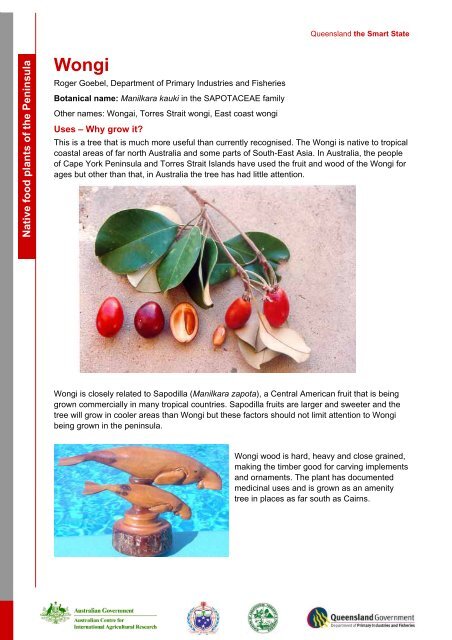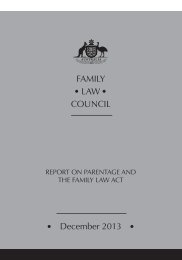Bk64D3Sg
Bk64D3Sg
Bk64D3Sg
Create successful ePaper yourself
Turn your PDF publications into a flip-book with our unique Google optimized e-Paper software.
Native food plants of the Peninsula<br />
Wongi<br />
Roger Goebel, Department of Primary Industries and Fisheries<br />
Botanical name: Manilkara kauki in the SAPOTACEAE family<br />
Other names: Wongai, Torres Strait wongi, East coast wongi<br />
Uses – Why grow it?<br />
Queensland the Smart State<br />
This is a tree that is much more useful than currently recognised. The Wongi is native to tropical<br />
coastal areas of far north Australia and some parts of South-East Asia. In Australia, the people<br />
of Cape York Peninsula and Torres Strait Islands have used the fruit and wood of the Wongi for<br />
ages but other than that, in Australia the tree has had little attention.<br />
Wongi<br />
is closely related to Sapodilla (Manilkara zapota), a Central American fruit that is being<br />
grown commercially in many tropical countries. Sapodilla fruits are larger and sweeter and the<br />
tree will grow in cooler areas than Wongi but these factors should not limit attention to Wongi<br />
being grown in the peninsula.<br />
Wongi<br />
wood is hard, heavy and close grained,<br />
making the timber good for carving implements<br />
and ornaments. The plant has documented<br />
medicinal uses and is grown as an amenity<br />
tree in places as far south as Cairns.
Before you start<br />
Can I grow this Crop?<br />
In the wild, this tree can be found growing in locations from exposed, windy sites close to the<br />
sea to sheltered positions behind the coastal hills. Under favourable conditions wongi can<br />
produce their first fruit within five years. Planting material is not readily available from nurseries<br />
so trees will need to be grown by an arrangement with a suitable nursery.<br />
Site Selection<br />
Although stressful conditions will result in slow growth and a longer time till fruiting, the timber<br />
will be denser and have a more interesting grain for woodworking purposes. For best fruit<br />
production, choose a site that is protected from strong winds and has well drained soil of<br />
reasonable fertility. Wongi don’t grow in swampy ground. Mature trees can grow to a height of<br />
over ten meters and have a spreading canopy so they need plenty of room or occasional<br />
pruning.<br />
Wongi grow best in full sun to light shade conditions. They don’t need shade trees and grow<br />
better without competition from other plants.<br />
Varieties<br />
Tree and fruit characteristics vary. Most trees produce oval shaped fruit between 3 and 5 cm<br />
long by 3 cm across with one to two light tan coloured seeds with very hard shells. Flesh<br />
recovery can be over 60%. By looking for better trees and planting their seedlings where they<br />
can be protected and studied, more information on the crop can be learnt and opportunities for<br />
new uses are more likely. In different areas local people will often know where the better fruiting<br />
trees are. Another tree called wongi grows abundantly along the sand dunes of the western<br />
coast of the peninsula. This plant is smaller. It has edible fruit that is smaller and juicy. The deep<br />
red juice leaves a beetroot/mulberry like stain on hands and clothes.<br />
How to grow<br />
Planting material<br />
Seedling trees are most often used but selected wongi<br />
trees can be propagated by grafting and possible<br />
marcotting or air layering smaller branches. Under<br />
normal nursery conditions fresh seed will germinate<br />
evenly and usually within one to two months. Plant the<br />
seed shallow, not buried completely, in well drained mix<br />
and keep the mix moist.<br />
Use larger tubes as young plants don’t like being<br />
disturbed. Three to five litre pots or bags are suitable as<br />
plants may take one year to reach a suitable size for<br />
planting out.<br />
Site preparation<br />
Minimal preparation is needed for most situations.<br />
Planting and care<br />
Make sure trees to be planted are in good health and<br />
strong enough to not suffer during the transplant. Trees<br />
should be about forty cm high with a base of the trunk<br />
diameter of more than one cm. Trees should be fully sun hardened prior to planting. To reduce<br />
2
transplant stress, soak the trees in a tub of water just before un-potting. Remove the plant.<br />
Upturn and gently tap plants out of plant pots but cut the trees out of plastic planter bags. In<br />
both cases tease the roots a little before placing in its hole. Gently fill in with topsoil while<br />
compacting with water. Complete the planting by tying to a stake for support while the plant<br />
settles.<br />
Fertilising<br />
Apply well rotted compost two or three times in a year to the ground beneath the canopy. Large<br />
amounts of fertiliser will shock the plant and can burn its roots.<br />
Irrigation<br />
Trees will benefit from being irrigated during extended dry periods in their first two or three<br />
years, until they are well established. They seem to tolerate poorer quality water but not water<br />
with high levels of salt.<br />
Problems (pests, diseases and weeds)<br />
Leaves of young trees can be attacked by case moth larvae and mature fruit are eagerly sought<br />
by birds, flying foxes and fruit flies. Seed of mature fruit can be attacked by a seed weevil that<br />
drills a small neat hole in the hard seed shell.<br />
Harvesting, selling and using<br />
Harvesting<br />
Trees vary in fruiting times with fruit usually available from May to August. The fruit can be<br />
picked when mature and stored till it darkens and becomes soft. Before fruits become fully ripe<br />
they exude a sticky white sap which can cause some problems in harvesting.<br />
Under good conditions a five year old tree can produce one to two kilograms of fruit. The fruit on<br />
a tree ripen over a period of a month or two so hand picking is needed.<br />
Selling<br />
There are various Australian native plant food product buyers who may be interested in buying<br />
this product but its short shelf life, need for careful handling and its seasonality are problems in<br />
marketing it as a fresh fruit. Local processing like drying, jam or sauce making would be worth<br />
looking into.<br />
Ensure you have marketing arrangements in place to sell the crop before considerable outlays<br />
are made.<br />
Using<br />
Both children and adults look forward to the fruiting<br />
season to eat the ripe fruit from trees near their<br />
communities.<br />
The fruit is popular to eat fresh after it is soft ripe or<br />
left to dry increasing its sweetness and flavour. Ripe<br />
wongi have a flavour and texture similar to dates.<br />
The flesh is usually eaten fresh but can be added to<br />
fruit cake mixes and breakfast cereal.<br />
3
Recipes<br />
Wongai Sabbi Domboy adapted from a recipe by Anima Pearson in “Torres Strait Cookbook”<br />
Ingredients<br />
• 50 ripe Wongai fruit cut in half, seeds removed<br />
• 2 cups of plain flour<br />
• 2 cups of coconut milk<br />
• 2 tablespoons of baking powder<br />
• Pinch of salt<br />
• Water<br />
Method<br />
1. Place flour, salt and baking powder in a bowl and mix<br />
2. Add enough water to make a dough<br />
3. Knead the dough till soft and lump free<br />
4. Into a saucepan combine the Wongai fruit and coconut milk and put on a low heat to boil<br />
5. Cut the dough into small bits and roll each into sausage shape Domboys<br />
6. Just as the mix starts to bubble add the Domboys and stir gently<br />
7. Leave the mix to cook for 3 minutes without stirring<br />
8. By this time the mix should reach boiling again and after a gentle mix the domboys are ready to<br />
serve. The Domboys are like dumplings that sponge up the coconut cream and wongai.<br />
Further reading<br />
• Plant Resources of South-East Asia (PROSEA) P.C.M. Jansen and others,1991 Basic<br />
list of species and commodity grouping ISBN 90 220 1055 4 and other volumes. Pudoc<br />
Wageningen the Netherlands.<br />
• Wongai an Australian fruit by Roger Goebel 1990Rare fruit council of Australia inc.<br />
newsletter63 July 1990 cover and 2 pages.<br />
Further information on horticulture<br />
DPI&F Business information centre on 13 25 23 – local call 8 am to 6 pm Monday Tuesday Thursday Friday. 9am to<br />
6pm Wednesday (non-Queensland residents, phone 07 3404 6999) E-mail callweb@dpi.qld.gov.au<br />
Native food plants of the Peninsula<br />
This information series is aimed at promoting gardening activities in Cape York Peninsula. The crop plants and<br />
gardening techniques outlined have been chosen with the specific requirements and constraints of the Cape York<br />
Peninsula Area in mind.<br />
Disclaimer<br />
Information contained in this publication is provided as general advice only. For application to specific circumstances,<br />
professional advice should be sought. While every care has been taken in preparing this publication, the State of<br />
Queensland accepts no responsibility for decisions or actions taken as a result of any data, information, statement or<br />
advice, expressed or implied, contained in this information.<br />
© The State of Queensland, Department of Primary Industries and Fisheries [2007]<br />
Inquiries should be addressed to copyright@dpi.qld.gov.au (telephone 61 7 3404 6999)<br />
Date of issue: Tuesday 13 th February 2007<br />
4




